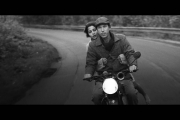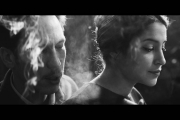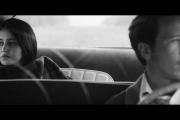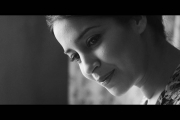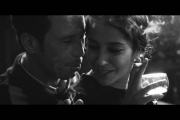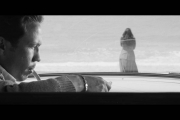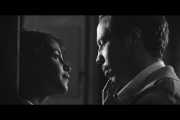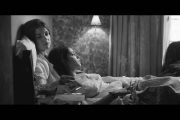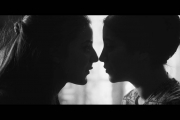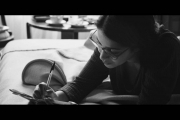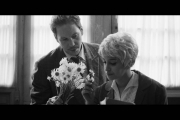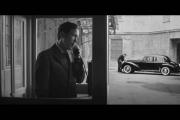![]() Presentation by and discussion with director and screenwriter Brigitte Sy
Presentation by and discussion with director and screenwriter Brigitte Sy
One night in April, 1957, twenty-year-old Albertine jumps off the prison wall, where she is serving time after a hold-up. In so doing, she breaks a bone in her foot: the astralagus. She is rescued by Julien, who takes her to a friend’s house in Paris to hide out. . .
Cast & Crew
Director • Brigitte Sy
Director of Photography • Frédéric Serve
Screenwriters • Brigitte Sy and Serge Le Péron
Producer • Paulo Branco
Music composer • Béatrice Thiriet
Based on Albertine Sarrazin’s autobiographical novel L’Astragale
Starring :
Leïla Bekhti, Reda Kateb…
Choose a picture to see the filmography (source : IMDB)
![]()
Director Brigitte Sy’s statement
L’Astragale is the true story of crazy love: that of a 20 year-old girl, Albertine Sarrazin for a man who took her in when she laid injured at the base of the prison wall from which she had just escaped one night in April 1957. Albertine’s freedom came to an end in June 1958, when she was arrested in Paris. My film is situated between these two dates.
L’Astragale is an extraordinary story because of the miraculous meeting of Albertine and Julien and it is even more intense because they are prevented from staying together.
Thanks to him, she is able to walk again. She suffers from her physical wound but even more, she suffers from love.
This is also the portrait of a young woman whose passion for all things extreme, her love of freedom and the headiness of youth, make her an eternally modern heroine. Albertine belongs to nothing, she belongs to herself. She is her own world, her earth, her own planet. A fiery planet that will later explode…
She is on the run and at war with anything that holds her back at a time when Algeria is a bloodbath, when the first terrorist attacks take place in France and the hunt for the Algerian National Liberation Front is launched. Albertine was born in Algeria, abandoned and then adopted by a French couple; she “knows nothing” of her Arabic roots. She wanders the streets of Paris and travels the length and breadth of France. She is hunted and every minute of freedom could well be her last; every frown could mean the threat of betrayal.
Even though her extraordinary ability to believe herself indestructible saves her from the dangers looming over her, it is more her indomitable need to write that saves her. Writing is Albertine’s skin. To get through to her body and her soul, she would have to have been prevented from writing.
Her escape, prostitution, solitude, expectations and risks taken are all to stay alive, to continue living until she can be with Julien.
Leïla Bekhti and Reda Kateb
It was in the morning of the day when I first heard the voice of the Judeo-Arabic singer Line Monty (we hear her singing in the film) that I imagined offering the role of Albertine to Leïla Bekhti.
It was in the evening of the day when when Leïla agreed that I offered the role of Julien to Reda Kateb. Albertine and Julien Sarrazin both said “I do” a second time when the faces of Leïla and Reda were brought together in an image from my film.
I truly believe that Leïla was destined to meet Albertine Sarrazin in her acting life as well as in her own life. I know this meeting happened and I know how right and necessary it was – both to the film and to Leïla.
I was familiar with Julien Sarrazin’s gentleness, his humaneness, his generosity. I understood all that when I met Arlette Pautou, his second wife, with Reda Kateb. Arlette told us all about Julien. I knew Reda as an actor, I didn’t know him as a person; gentle, good and generous.
When we took our leave of Arlette, she looked at Reda and –without doing it on purpose – she said “Goodbye Julien”. We smiled and left feeling confident.
The period
From the escape to the hold-up via prostitution as a choice and her homosexual love affairs, Albertine’s character is in stark contrast to the ultra-conservative France of the late 1950s.
Making a period film means refusing to prove every five minutes that the outward appearance of the film (costumes, cars, hairstyles, furniture) is absolutely accurate for fear of it becoming a show in itself.
Prior to the shooting, I saw Marcel Hanoun’s film, Une Simple Histoire, made in 1957. I recognised the frames and the lighting I had imagined for my film. So I thought that the formal stringency of this film made in 1957 – which in fact did not have to prove it – would be my example and a reference for styling the décors we wanted to use. For Frédéric Serve, the director of photography and myself, it was by using the sobriety of the sets and rigorous work on the lighting that we thought it would be possible to make this period credible; likewise for the streets in Paris where Albertine Sarrazin’s footsteps still ring when I wander there at certain hours of the day.
Press Kit “L’Astragale”
French ~ 12 pages ~ 3,6 Mo ~ pdf



